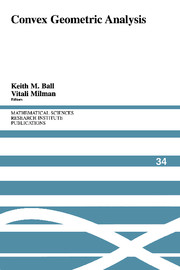Book contents
- Frontmatter
- Contents
- Introduction: The Convex Geometry and Geometric Analysis Program MSRI, Spring 1996
- Msri Program Seminars
- Integrals of Smooth and Analytic Functions over Minkowski's Sums of Convex Sets
- Localization Technique on the Sphere and the Gromov-Milman Theorem on the Concentration Phenomenon on Uniformly Convex Sphere
- Geometric Inequalities in Option Pricing
- Random Points in Isotropic Convex Sets
- Threshold Intervals under Group Symmetries
- On a Generalization of the Busemann-Petty Problem
- Isotropic Constants of Schatten Class Spaces
- On the Stability of the Volume Radius
- Polytope Approximations of the Unit Ball of ℓnp
- A Remark about the Scalar-Plus-Compact Problem
- Another Low-Technology Estimate in Convex Geometry
- On the Equivalence Between Geometric and Arithmetic Means for Log-Concave Measures
- On the Constant in the Reverse Brunn-Minkowski Inequality for p-Convex Balls
- The Extension of the Finite-Dimensional Version of Krivine's Theorem to Quasi-Normed Spaces
- A Note on Gowers' Dichotomy Theorem
- An "Isomorphic" Version of Dvoretzky's Theorem, II
- Asymptotic Versions of Operators and Operator Ideals
- Metric Entropy of the Grassmann Manifold
- Curvature of Nonlocal Markov Generators
- An Extremal Property of the Regular Simplex
- Floating Body, Illumination Body, and Polytopal Approximation
- A Note on the M*-Limiting Convolution Body
Polytope Approximations of the Unit Ball of ℓnp
Published online by Cambridge University Press: 27 June 2025
- Frontmatter
- Contents
- Introduction: The Convex Geometry and Geometric Analysis Program MSRI, Spring 1996
- Msri Program Seminars
- Integrals of Smooth and Analytic Functions over Minkowski's Sums of Convex Sets
- Localization Technique on the Sphere and the Gromov-Milman Theorem on the Concentration Phenomenon on Uniformly Convex Sphere
- Geometric Inequalities in Option Pricing
- Random Points in Isotropic Convex Sets
- Threshold Intervals under Group Symmetries
- On a Generalization of the Busemann-Petty Problem
- Isotropic Constants of Schatten Class Spaces
- On the Stability of the Volume Radius
- Polytope Approximations of the Unit Ball of ℓnp
- A Remark about the Scalar-Plus-Compact Problem
- Another Low-Technology Estimate in Convex Geometry
- On the Equivalence Between Geometric and Arithmetic Means for Log-Concave Measures
- On the Constant in the Reverse Brunn-Minkowski Inequality for p-Convex Balls
- The Extension of the Finite-Dimensional Version of Krivine's Theorem to Quasi-Normed Spaces
- A Note on Gowers' Dichotomy Theorem
- An "Isomorphic" Version of Dvoretzky's Theorem, II
- Asymptotic Versions of Operators and Operator Ideals
- Metric Entropy of the Grassmann Manifold
- Curvature of Nonlocal Markov Generators
- An Extremal Property of the Regular Simplex
- Floating Body, Illumination Body, and Polytopal Approximation
- A Note on the M*-Limiting Convolution Body
Summary
A simple and explicit method is given for approximating the unit ball of ℓnp by polytopes. The method leads to a natural generalization of £p-spaces with good duality and interpolation properties.
1. Introduction
The classical spaces ℓp and Lp are the best known and in many ways most fundamental examples of Banach spaces. In view of their interesting properties it is natural to ask whether the role of the function tP in these spaces can be played by other more general functions. This question was answered by Orlicz, who defined a certain class of functions, now known as Orlicz functions, and associated with each one a sequence space and a function space, now called an Orlicz sequence space and Orlicz function space. The Orlicz spaces are generally regarded as the correct and most natural spaces to associate with given Orlicz functions.
One of the aims of this paper is to cast doubt on that view, at least in its isometric interpretation. We shall do this by discussing a different generalization which arises geometrically and has two desirable isometric properties lacked by Orlicz spaces. First, the dual of one of our spaces is isometric to another such space. Second, complex interpolation between two of our spaces yields a third in a natural way. Irritatingly, we have not managed to establish whether our new spaces are isomorphic to Orlicz spaces, in which case they are a useful renorming of them, or whether they are completely different. Our route to the new generalization starts with an unusual (perhaps even eccentric) problem which will be described below, and which relates more to the polytope approximations of the title.
Information
- Type
- Chapter
- Information
- Convex Geometric Analysis , pp. 89 - 110Publisher: Cambridge University PressPrint publication year: 1999
